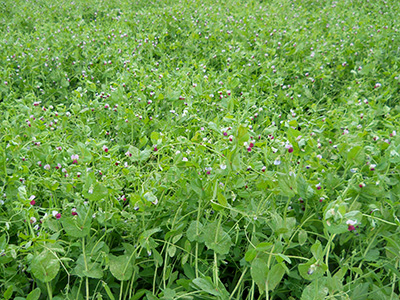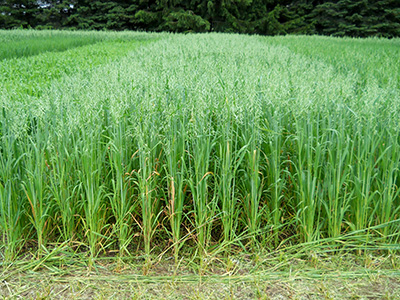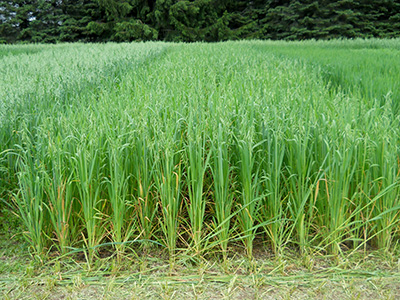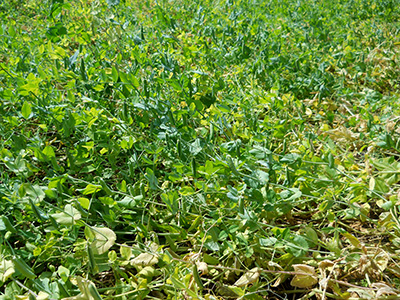By Jim Isleib
Oat and forage pea mixtures can provide a good quality and good yielding forage option for livestock and dairy producers. Oats and peas can be planted as a nurse crop for alfalfa or other hay seedings, or grown alone. The addition of peas to oats or other small grains including barley or triticale grown for forage does not necessarily improve yield, although it can increase yields from 0-0.5 tons dry matter per acre. The main reason for including peas is the positive effect on protein content and palatability of the resulting ensiled forage.
Early seeding will result in the best crop. Harvest timing of oat/pea forage also has a large impact on yield and quality. Timing of harvest is usually determined by the developmental stage of the oats or other small grain, which normally makes up most of the tonnage. Harvesting at the boot stage of the oats results in higher protein content and improved digestibility. This is most desirable if the forage is fed to dairy cattle. For beef or non-lactating cattle and other livestock, harvest at the early heading stage of the small grain will result in lower forage quality, but will maximize yield of acceptable quality.
Another important detail involved in growing oat and forage pea mixtures is the relative timing of flowering and maturity of the oat and pea varieties in the seed mixture. Ideally, the pea variety should start flowering a few days before the oats head out. The flowering period of peas is considerably longer than the flowering period of oats, so the peas will continue to flower along with oats. If the peas flower many days, or weeks, ahead of the oats, they will lose forage quality by the time the oats are ready for chopping.
Seed companies and dealers strive to combine appropriate small grain and forage pea varieties to achieve the best possible forage quality. However, if you are growing or considering growing a small grain/forage pea combination, be sure to observe the relative flowering times of the plants. If the oats are way behind the peas, you should look for a different combination.
A Michigan oat and forage pea seed grower is exploring the relative maturity of potential seed products for himself. He planted two sets of strip plots including four oat varieties for maturity and height comparison. He is considering collaborating with Michigan State University Extension to expand the project to include replicated plots on his and possibly other interested farms and collect yield and quality data. The following photos for this year’s plots demonstrate the significant differences in various oat varieties relative to the forage pea variety he grows. The July 11 photos (end of article) show the proper stage to harvest the peas, at flowering with beginning podding.
From this on-farm comparison, it appears Goliath oats fit well with the 4010 forage peas. Based on oat height, it is also logical to assume the yield of the Goliath oats will be superior as forage on this farm.
For more information on growing small grain/forage pea combinations, take a look at the following articles:
- Oats and Peas as Alternative Forage by Vance Owens, Thandiwe Nleya and Peter Jeranyama, South Dakota State University
- Growing Grasses and Legumes Together by Steve Zwinger, North Dakota State University
- Alternate Forage Crops: Planting Dates, Yield and Quality Potential by Dan Undersander, University of Wisconsin
Oat and pea forage pictures, taken July 11, 2016

4010 forage peas.

Goliath oats, 41 in, mostly headed and mid-anthesis.

Paul oats hulless, 37 in, two days behind Goliath.

Forage Plus oats, 33 in, just starting to head.

Everleaf 126, 26 in, early boot stage, not heading, developed in New Zealand.
Oat and pea forage pictures, taken Aug. 2, 2016

4010 forage peas II.
Source:msu.edu